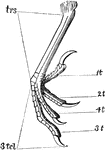Clipart tagged: ‘tarsus’

Leg of Bear
This illustration shows the plantigrade leg of a bear. Plantigrade means that the animal walks flat…

Carrion Beetle
"Carrion-beetle (Silpha inaequalis). a, larva; d, same; f, g, h, mandible, labium, and maxilla of larva;…
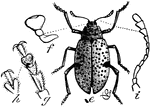
Fungus Beetle
Erotylus boisduvali, a fungus beetle. "e, beetle; f, palpus; g, tarsus, from below; h, terminal joint…

Bird Parts
"1. Lower mandible. 2. Upper mandible. 3. Forehead. 4. Loral space. 5. Crown of the head. 6. Hind part…
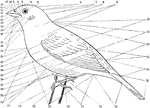
Topography of a Bird
"fig. 25 - Topography of a Bird. 1, forehead (frons). 2, lore. 3, circumocular region. 4, crown (vertex).…

The Bill of a Bittern
"Botaurus. Bittern. Bill moderately longer than head, shorter than tarsus, which is shorter than middle…

The Foot of a Bridled Foot
"Sterna anaisthetikos. Bridled Tern. The foot of a Bridled Tern; Tarsus .85; middle toe the same, with…

Scutellate Laminiplanter Tarsus of a Cat-bird
"Figure shows Scutellate laminiplanter tarsus of a cat-bird. A tarsus so disposed as to its podotheca…
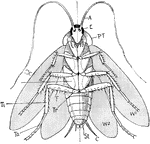
Cockroach
"Ventral aspect of male cockroach with the wings extended. An imaginary median line has been inserted.…

Cockroach Leg
"Leg of cockroach. c., Broad expanded coxa; tr., trochanter; f., femur; ti., tibia; ta., six-jointed…

Side View of the Bone of the Foot
Bones of the foot, side view. In this figure the bones of the tarsus extend from the heel to a;…

Bones of the Foot
Bones of the foot. At e d f g h are the 7 bones of the tarsus; at a are the 5 bones…

Bones of Human Foot
"Bones of Human Foot, or Pes, the third principal segment of the hind limb, consisting of tarsus, metatarsus,…

Oblique Anteroposterior Section of
Oblique anteroposterior section of foot, to show the synovial cavities of the tarsus. Labels: 1, tibia;…

Laughing Gull Bill
"Chroicocephalus atricilla. Laughing Gull. Black-headed Gull. Bill longer than middle toe and claw,…
Human Leg (Front View)
This illustration shows a front view of a human leg. P. Pelvis, FE. Femur, TI. Tibia, FI. Fibula, TA.…

Human Leg (Front View), and Comparative Diagrams showing Modifications of the Leg
This illustration shows a human leg (front view), and comparative diagrams showing modifications of…

Human Leg (Side View)
This illustration shows a side view of a human leg. P. Pelvis, FE. Femur, TI. Tibia, FI. Fibula, TA.…
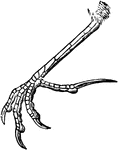
Lark Foot
"Scutelliplantar foot of horned lark: the tarsus scutellate before and behind, and the toes all scutellate…
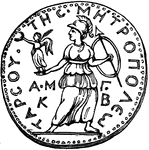
Medal of Tarsus
A medal of Tarsus which suggest that Minerva, the goddess of arts and sciences, was revered there. In…

Oyster-catcher Bill
"Haematopus. Oyster-catcher. Bill peculiar - longer than tarsus, twice as long as head, constricted…

Penguin
"The Penguins are aquatic birds confined to the high S. latitudes or both hemispheres, where they congregate…
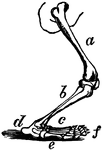
Polar Bear Leg
The polar bear, Plantigrada, is part of the subdivision Carnivora, which includes other carnivorous…

Polar Bear Leg
The anatomy of a polar bear's leg. a, femur (thigh); b, tibia (leg); c, tarsus and metatarsus (foot);…

Tarsus of a Horse
Bones of left tarsus of a horse, seen from in front and outside. Labels: 1, calcaneum; 2, astragalus;…
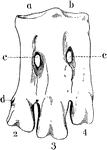
Front Left Tarsus of a Penguin
An illustration of the front left tarsus of a penguin. "a, articular facet for inner condyle of tibia;…

Sooty Tern Foot
"Sterna fuliginosa. Sooty Tern. feet stout; toes short; with much incised webs; tibia bare .70; tarsus…





